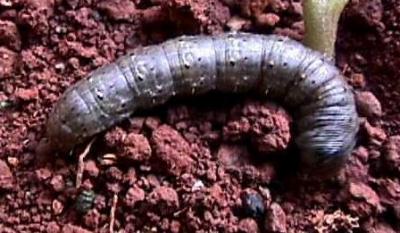

3.1.08 sr: notes ana: match the host plants list with the respective datasheets; although cutworms have many host plants, they are no major pests of all of them, therefore they have not been included in all datasheets of the above mentioned crops; s. by monitoring and decision making: pheromone traps are not available locally. economic threshold for which crop? where? under which conditions?;
Cutworms (Agrotis segetum and the cotton leafworm, Spodoptera littoralis)
Caterpillars cut seedlings at ground level. They can be found in the soil up to a depth of about 5cm around the plant host. Caterpillars of the cotton leafworm are up to 45 mm long. Their colour varies from yellowish white to bluish grey and greyish brown. On the dorsal side of the caterpillars there are usually w rows of triangular black spots. These spots can be absent with the exception of those at the fore and hind part of the body. Although the caterpillars feed mainly on leaves, they occasionally cut plants and attack fruits.
- Remove weeds in and around the fields as a preventive measure to reduce the number of sites where the moths can lay eggs. Do this at least 2-3 weeks before planting.
- Plough and harrow fields properly before planting to destroy eggs and expose caterpillars to birds, ants and other predators.
- Apply neem cake or de-oiled castor cake before sowing.
- Encourage the presence of birds with trees and hedges. Also promote natural enemies like spiders, ground beetles and lacewings.
- Interplant with onion, garlic, peppermint or coriander, this will act as a repellent to cutworms.
- Sunflowers can be planted as a trap crop.
